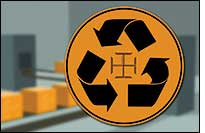Radio frequency identification could dramatically improve supply chain efficiencies, but putting RFID tags on millions—perhaps billions—of corrugated boxes could cause environmental problems. Boxes with copper antennas might not be recyclable, and the silver in conductive inks could leach into drinking water if boxes with printed antennas are tossed into landfills. A company called ADASA thinks it has the solution—recyclable RFID tags.
“A reusable or recyclable tag can be made more robust, so it can perform better and more consistently than a very low cost tag that is designed to be thrown away,” says Clarke McAllister, president of ADASA.
|
|
ADASA is working with unnamed RFID tag manufacturers on ways to create green tags. Instead of smart labels with human-readable or bar code information, green tags would be made with rigid materials to protect the transponders. Special adhesives would allow tags to be removed from corrugated boxes and other containers before the boxes are recycled. And the tags would have a logo identifying them as recyclable.
McAllister says his company has developed patent-pending technology that would remove and collect the tags. He expects to license the technology to companies that recycle boxes for retailers today. “We want to enable them to adapt to this new technology,” McAllister says. ADASA would collect royalties on the technology, and it might also make money by managing the pool of recycled tags.
In addition to keeping millions of tags out of world landfills, ADASA’s recycling plan could save manufacturers millions of dollars as they meet tagging requirements made by their large retail customers. Instead of buying disposable tags, they could buy green tags and reuse them. The tags would be more expensive, but the cost could be amortized over the life of the tags.
“The working life of a tag might be five years or more, but we’re throwing them away after 60 to 90 days,” says McAllister. “We’re taking advantage of only a fraction of the working life of this miniature wireless computer.”
Ken Phillips, ADASA’s chief operating officer, also points out that the supply chain doesn’t end at retail stores, but at landfills. He says that the goal will be to recover tags as quickly as possible, after they have completed their mission. “The longer you wait [after the tag has been used], the more you risk not recovering the tag. We have to interrupt the waste stream somewhere along the line. For corrugated boxes, the solution will depend on retailers.”
McAllister and Phillips say manufacturers like the concept of a reusable tag, but they concede that some end users think the idea of recovering tags cost-effectively is, well, rubbish. They plan to launch a pilot in the third or fourth quarter of this year to prove the concept. “Once we prove that tag recycling is viable,” says McAllister, “we think it will take off.”


